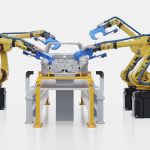Legacy intake and orchestration systems were built for process efficiency—not for the dynamic, multi-variable procurement environments leaders face today. Agent-based models within a metaprise framework offer the adaptability and intelligence needed to keep pace.
Traditional Procurement Platforms Are No Longer Built for the Real World
The conventional approach to digital procurement—streamlined intake, orchestrated workflows, and predefined logic—was designed for process control. And it worked, for a time. But the past five years have changed the rules. Supply risk is now dynamic, ESG priorities are non-negotiable, and global procurement leaders are being asked to make decisions faster, with more variables in play than ever before. Equation-based orchestration platforms were not built for this world.
That’s where agent-based models come in. Designed around autonomous digital actors that represent buyers, suppliers, and other stakeholders, these systems evolve, negotiate, and adapt without needing every scenario to be hardcoded. When embedded within a metaprise—a broader ecosystem of interconnected platforms and partners—they enable procurement to shift from rigid process execution to intelligent, decentralized decision-making.
This isn’t a tactical enhancement. It’s a structural shift in how procurement operates.
What Makes the Agent-Based Model Different
Most digital platforms still rely on static logic: if a supplier fails, move to the next preferred vendor. But that logic assumes the next vendor is unaffected by the same disruption—which in today’s global supply chains, is rarely true.
Agent-based models operate differently. They continuously analyze real-time inputs, learning from patterns and adjusting actions across the system. An agent might recommend shifting to a regionally diversified supplier, renegotiating contract terms, or delaying an order based on logistics congestion or ESG compliance—all without requiring manual intervention or new workflow coding.
This is what sets the agent-based model apart: its ability to manage uncertainty not as a risk to be contained, but as a normal operating condition to be optimized.
In a 2024 report on supply chain technology, EY wrote: “The ability to simulate, negotiate, and respond to disruption in real time will be the defining capability of high-performing procurement functions over the next decade. Traditional workflow tools were built to optimise certainty—agent-based models are designed for uncertainty.”
It’s a sharp distinction—and one procurement leaders must now act on.
What Procurement Leaders Should Do Now
The next chapter of procurement leadership won’t be written by those who simply digitize legacy processes. It will belong to those who design systems that can adapt faster than the disruptions they face. To begin that shift, leaders should take three steps:
Start by re-evaluating your current system architecture. Identify where fixed logic is limiting your agility—especially in categories impacted by shifting regulations, climate risk, or geopolitical volatility.
Then, test agent-based logic where it matters most. Start small—focus on one area of volatility, one critical supplier ecosystem, or one ESG-sensitive category. Use this to understand how adaptive systems behave in real conditions.
Finally, shift your operating model to enable this transformation. That means investing in teams who can interpret emergent data, build trust across the supply base, and guide decisions that algorithms alone can’t resolve.
What to Expect: Greater Agility, Resilience—and Strategic Visibility
Procurement leaders who adopt agent-based models within a metaprise framework won’t just reduce operational risk—they’ll unlock competitive advantage. These systems reveal signals that static tools overlook: emerging supplier opportunities, sustainability trade-offs, and early-warning signs of disruption across tiers.
In practical terms, this means faster response times, stronger supplier collaboration, and smarter allocation of spend against strategic goals. But more than that, it changes procurement’s role—from enforcing policy to enabling enterprise agility. And for those willing to make the shift, that future is already within reach.





